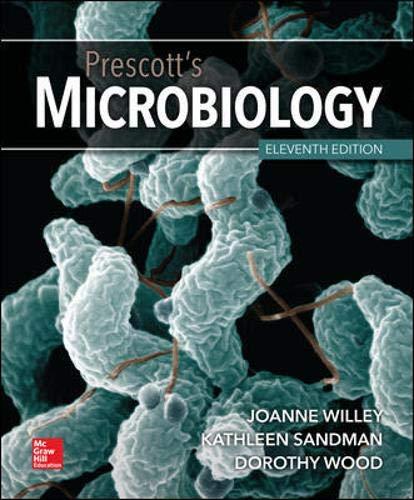
Prescott's Microbiology
11th Edition
ISBN: 9781260211887
Author: WILLEY, Sandman, Wood
Publisher: McGraw Hill
expand_more
expand_more
format_list_bulleted
Concept explainers
Textbook Question
Chapter 4, Problem 3AL
Compare, Hypothesize, Invent
3. As we note in section 4.3, archaeal ribosomal proteins can be divided into three classes: (1) those with homologues in all three domains of life, (2) those unique to archaea, and (3) those with homologues in eukaryotic ribosomes. Predict a class of archaeal ribosomal proteins that would refute the argument made by some microbiologists that the term prokaryote should be abandoned.
Expert Solution & Answer
Want to see the full answer?
Check out a sample textbook solution
Students have asked these similar questions
Microbiologists debate the use of biochemical similarities and cell features as a way of determining the taxonomic relationships among prokaryotes. Explain why some microbiologists believe these similarities and differences are a powerful taxonomic indicator, whereas others think they are not very useful for that purpose.
.Answer the following question briefly but concisely
1. What aspect of a cell's physical makeup increases gradually as it gets smaller?
2. How could Bacteria and Archaea's tiny size and haploid genome hasten their evolution?
3. How small a cell can get? Justify.
4. If a bacterial cell was enclosed in a capsule, could it do without a cell wall? Why, or why not?
5. Why can gram-negative sulfur-oxidizing chemolithotrophs store sulfur but gram-positive bacteria cannot?
just answer question --- dont need explanation
Chapter 4 Solutions
Prescott's Microbiology
Ch. 4.1 - Retrieve, Infer, Apply 1. Which cell shapes are...Ch. 4.1 - Retrieve, Infer, Apply 2. Archaea was first...Ch. 4.2 - MICRO INQUIRY How is pseudomurein similar to...Ch. 4.2 - Retrieve, Infer, Apply 1. Identify three features...Ch. 4.2 - Prob. 2CCCh. 4.3 - Thus far, homologues of intermediate filaments...Ch. 4.3 - Retrieve, Infer, Apply 2. Archaea are often...Ch. 4.4 - Retrieve, Infer, Apply 2. What observations about...Ch. 4.4 - Retrieve, Infer, Apply 3. List three aspects of...Ch. 4.4 - Prob. 3CC
Knowledge Booster
Learn more about
Need a deep-dive on the concept behind this application? Look no further. Learn more about this topic, biology and related others by exploring similar questions and additional content below.Similar questions
- 19arrow_forwardMulticellular organisms with a true nucleus, histone proteins, ester-linked fatty acids in their cellmembranes, opisthokont ancestry, and chitin cell walls, are most likely to be:A. members of kingdom ArchaeobacteriaB. members of kingdom EubacteriaC. members of kingdom AnimaliaD. members of kingdom PlantaeE. members of kingdom Fungarrow_forwardArchaea contains? Choose the right answer: a. A nucleus with a virus cell b. A group of spine animals. c. Cells with a nucleus. d. A group of one-celled organisms with no nucleus in their cells.arrow_forward
- What are the answers to these questions?arrow_forwardCompare and contrast archaeal and bacterial cell wall structure (peptidoglycan and pseudomurein) in terms of their structures, location variations in cell, and functions (Prepare in table form).arrow_forwardQuestion:- Explain why prokaryotic cells are not really primitive. Include examples.arrow_forward
- just answer question --- dont need explanationarrow_forwardI pis Walden Pond 5: While you were collecting your pond samples, you were troubled by the organism seen below, which was continually biting you: Domain and Kingdom? [ Choose ] can this organism act as an "arthropod vector" of microbial pathogens? [Choose] uestion 51arrow_forwardUsing a copyright free image, 6) Please diagram and label a generalized eukaryotic cell. Include a onesentence description of what the organelles and various compartments of thecell do.arrow_forward
arrow_back_ios
SEE MORE QUESTIONS
arrow_forward_ios
Recommended textbooks for you
 Biology (MindTap Course List)BiologyISBN:9781337392938Author:Eldra Solomon, Charles Martin, Diana W. Martin, Linda R. BergPublisher:Cengage Learning
Biology (MindTap Course List)BiologyISBN:9781337392938Author:Eldra Solomon, Charles Martin, Diana W. Martin, Linda R. BergPublisher:Cengage Learning

Biology (MindTap Course List)
Biology
ISBN:9781337392938
Author:Eldra Solomon, Charles Martin, Diana W. Martin, Linda R. Berg
Publisher:Cengage Learning
Archaea; Author: Bozeman Science;https://www.youtube.com/watch?v=W25nI9kpxtU;License: Standard youtube license